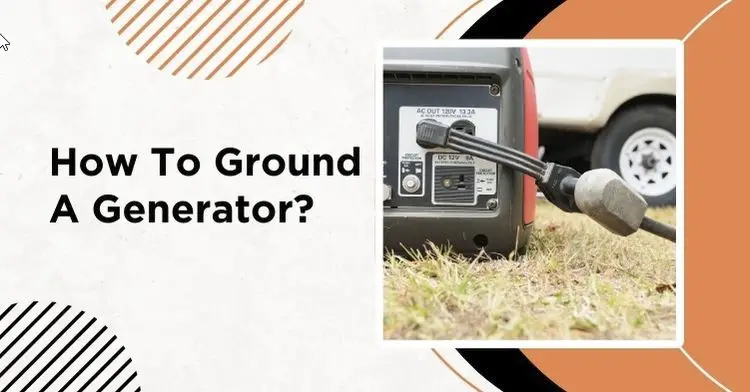An Easy And Detailed Guide On How To Ground A Generator
Have you ever had such a situation that you are in nature, perhaps somewhere in the mountains or a forest, and you needed access to electricity, for example, to charge your devices? If you find yourself in such a situation, then you thought about buying portable generators, but another question is how to properly use this source of electricity.
In this article, I will try to find the main answer to the question: how to ground a portable generator? I will also analyze different methods and even different models of generators so that you can deeply understand how to use your device correctly.

Contents
- 1 What is a portable generator?
- 2 Should You Ground A Portable Generator?
- 3 What does it mean to ground a generator?
- 4 What Will Happen If You Don’t ground the Generator?
- 5 What is a copper grounding wire?
- 6 Methods to ground a generator
- 7 Instruction on grounding your portable generator
- 8 Bonded neutral generator vs. floating neutral generator
- 9 Conclusion
- 10 Frequently Asked Questions (FAQs):
What is a portable generator?
A portable generator is a device that, by turning a turbine and using gas or fuel, creates a flow of electricity, regardless of its location.
Most often, portable generators differ from conventional ones precisely in their size, as they are made for easy portability between locations.
They are especially popular among people who like to relax in nature, away from the city’s electrical system. Since portable generators are great for activating and charging small devices, such as a phone or computers, they consume quite a small amount of gas and fuel. Unlike conventional generators, they won’t be able to provide electricity to a large area, f. e. house.
Should You Ground A Portable Generator?
A portable generator that has metal parts, such as an engine, must be grounded using, for example, copper wire. To determine if a generator is grounded in your area, simply measure the resistance between the generator and the grounding rod with a digital multimeter. This must be done to be sure of the reliability and protection from electricity.

What does it mean to ground a generator?
Grounding is establishing a connection using a ground rod or copper rod between the generator frame and the ground. This is done so that electricity, which easily passes through the material part of the generator, cannot in any way harm the environment surrounding the generator, that is, the people who use it.
That is, all the current from the normal electrical circuit enters the ground and cannot harm a person in any way, but besides this, grounding also prevents the engine from breaking down, since the likelihood of electrical damage is reduced. At the same time, three types of grounding can be distinguished, based specifically on the electrical system:
Direct
This type of grounding portable generator is one of the most used because of the simplicity of design and operation. You just need to take the wire that is connected to the generator and bury it in the ground. It is very similar to conventional electrical system grounding, the only difference is that it is common for buildings to ground electricity on gas pipes.
Indirect
This grounding system is different in that the generator’s electrical system is not simply buried like a wire or a rod. You need to use a conductor, such as a metal pipe. This method is used when the land is less accessible, and you need to lengthen and still secure the flow of electricity.
Isolated
This method of grounding is used only in cases where there is almost no ground nearby. In this case, the electrical system is connected to an underground metal plate.
Also, this method is one of the safest, since it cannot electrically reach users in any way, being underground and chained to a metal plate.

What Will Happen If You Don’t ground the Generator?
First and foremost, if you don’t ground the generator, you risk your health. The metal case of the generator can pass electricity and if you touch it or even be near it, you can suffer from mild or severe electric shock. It is almost impossible to predict what kind of force an electric shock will be.
Secondly, your generator may also cease to be operational. Electricity can also harm the fuel tank, which can cause the fuel to ignite and, as a result, ignite the entire generator. After this, not only will the generator itself stop working, but also all the devices that were connected to it in the same way. Grounding provides protection not only for you but also for the generator.
What is a copper grounding wire?
Copper wire is made of copper and is most commonly used as a “ground wire”. By itself, it is quite dangerous, since the lack of insulation can cause an electric shock, on the other hand, precisely because this wire conducts electricity so well, it is perfect for a portable source of electricity.
Methods to ground a generator
The type of grounding depends on your generator and the conditions in which you want to use it. Below you can find three grounding methods and brief descriptions to understand which one is best for you:
Generator Frame
This grounding method is a portable generator with metal parts. Very often, such generators are used not only for camping trips but also for vans. The underlying structure of this method is a metal frame.
This grounding is quite simple, all you have to do is connect the screw of the generator to the ground wire with a bolt or screw.
Neutral Wires
This method is suitable for those generators that do not have a metal frame. Unlike the first method, here you need to connect the ground wire not to the bolt or screw, but as a neutral terminal of the generator, which replaces the metal frame in this kind of generator. You must remove the neutral terminal, sand down the metal part, and connect the wire.
Engine Block
The latter method is possible only with generators in which there is neither a metal frame nor a negative terminal at all. To ground such a generator, you need to connect the ground wire directly to the engine block, the location of which depends on the manufacturer of your generator. If you cannot find the engine block, refer to the owner’s manual.

Instruction on grounding your portable generator
Finally, I got to the answer to the main question, how can you still ground your portable generator? Before I start discussing the instruction itself, you should familiarize yourself with the tools and materials that you should have prepared in advance before starting the grounding process. But at first please read the user manual of your generator and if you are unsure contact an electrician who can help you.
Materials
- Adapter
- A grounding rod and copper wire
- Hammer
- Wire strippers and splices
If you have made sure that you have all the tools and materials, for example, the grounding bolt, then you can safely begin to disassemble in detail each step for the successful grounding of your generator.
First Step
First, you need to understand if your portable generator needs grounding. As mentioned earlier, you need to strike a special device with a digital multimeter and measure the resistance between the generator case and the grounding rod or copper rod. If you see that the multimeter shows a voltage above zero, then the generator must be grounded.
Second Step
Now you need to make sure that the generator will be on the ground that is completely suitable for it. That is, the terrain must be dry and firm for the position of the generator to be strong enough. Also, make sure that the sun’s rays and wind cannot harm your generator in any way.
Third Step
Finally, we come to the pinching process itself, you will need to drive the grounding rod into the ground, you can use a hammer or any other tool that is convenient for you. It is also best if the rod is made of the same material as copper wire or galvanized steel. However, you can use other tools instead of a rod, such as a metal underground pipe.
Fourth Step
Now you will need a ground wire, grounding rod, and wire strippers. The wire stripper will help you strip the insulation so that the grounded wire will work. Be very careful, then wrap the bare wire around the grounding rod. Make sure that the wire is tightly wrapped around the rod so that it cannot fly off in any way.
Fifth Step
The last step is to connect the ground rod and ground wire construction to the generator itself. After connecting, start the generator and again use the digital multimeter and check the level of electrical voltage, if you see any problems with voltage, contact the owner’s manual to understand what you did wrong.

Bonded neutral generator vs. floating neutral generator
A bonded neutral generator is a generator in which there is a connection between the ground wire, neutral, and ground. Whereas, a floating neutral generator is a generator where the case does not have any connection to the neutral wires.
That is, the ground wire has almost nothing to do with the neutral wire system.
It is the generator with a grounded neutral that is considered safer since its system for protecting the user from electric shock is more developed. Also, in a floating neutral generator, there is a high probability of current overload and damage to the generator case by an electric discharge.

Conclusion
I hope that after reading this article, the question “how to ground a generator” will no longer remain unanswered for you. Moreover, now you understand the benefits of grounding with a ground rod or wire, what grounding methods are, which portable generator is right for you, and a list of materials for safe and successful grounding.
Now you know how to ground a generator, but a generator can be very loud. If you are interested in how to quiet a generator and you can read the article: How to quiet a generator easily.
Frequently Asked Questions (FAQs):
Does a generator need to be grounded?
As we discussed earlier, not all portable generators need to be wired with copper wire and ground rod, but only those that have a metal casing that allows current to pass through.
What is the method used for grounding a generator?
There are only three methods, each of which suits different types of generators, the first method uses a metal frame and ground rod, the second uses neutral wires and the third uses a generator engine block.
Do you ground the neutral of a generator?
It is best to ground the neutral together with the ground rod, as firstly this will create protection, and secondly, it will save you misunderstandings and confusion with neutral, copper wire, and ground rods.
What materials do I need to ground a generator?
To ground a generator, you’ll typically need a grounding rod (copper or galvanized steel), grounding wire, clamps, and a grounding rod driver. Additionally, you may need a wrench or socket set to secure connections and ensure a proper ground.

